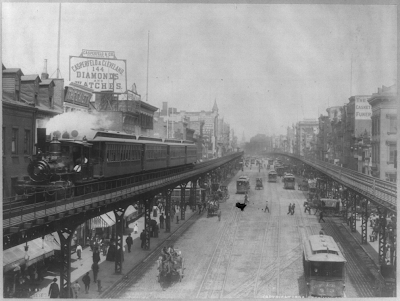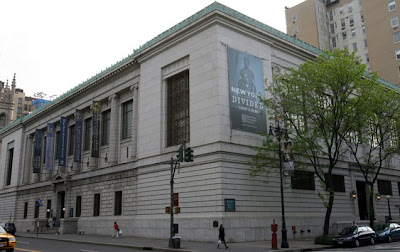 The Lower East Side History Project (LESHP), a non-profit organization dedicated to research, education and preservation, has announced its Summer 2011 walking tour schedule.
The Lower East Side History Project (LESHP), a non-profit organization dedicated to research, education and preservation, has announced its Summer 2011 walking tour schedule.
LESHP walking tours have been called a “Must do…-” by Frommers Guide (2009) and was ranked “Top Five in New York City” by Time Out New York (2010). New York Newsday announced, “Nothing will get you closer to the real thing…-” (2010) and NBC declared “You will be amazed…-” (2010).
LESHP’s stable of licensed tour guides are multigenerational, native New Yorkers with well over a century of personal insight. They are veteran educators, professional authors, movie consultants, researchers active in neighborhood politics, arts and culture. The organization is partnered with museums and cultural institutions in the City of New York and has unique access to images, documents and information.
The full schedule is below, but you can find out more online or call 347-465-7767.
LESHP Summer 2011 public walking tour schedule:
Alphabet City Walking Tour
Once the godforsaken broken heart of the ghetto, the most densely populated square mile on the face of the earth, built over an industrial wasteland, then abandoned to a wild mix of marginal artists, angry anarchists, gangs, dealers, excons and thieves, against a backdrop of urban blight, tenements burned to rubble and danger on every corner out of which grew jazz and the beat generation, graffiti art and punk rock, the squatters movement, the garden movement and radical underground cinema: there’s more to Alphabet City than meets the eye, stories that could happen only in metropolis’ darkest corner.
When: Every Saturday at 11:00am
Reservations: Not Required
Fee: $20 General Admission
Meet: Entrance to Tompkins Square Park, St. Marks and Avenue A
Subway: L train to 1st avenue or 6 train to Astor Place
Bowery Walking Tour
The Bowery is not just the oldest and most architecturally diverse thoroughfares in NYC, it is one of most historically significant streets in the country. Beyond the myths, legends and gritty reputation, the Bowery offers an absolute treasure trove of NYC and American history.
Once an important Native American trail, the Bowery has undergone many changes in its modern history. From elegant opera houses to rowdy working-class theaters- from America’s vice district controlled by gangs and crooked politicians to a haven for the homeless and downtrodden as “skid row” during the great depression- and from factories and warehouses to pioneering artist colonies. Today the Bowery has become a popular hotel, restaurant and nightclub district, but buried beneath the five-star offerings is a repository of social, economic, political, immigrant, labor, underground, criminal, deviant, marginal, counter-cultural, literary, musical, dramatic and artistic history.
When: Every Sunday at 11:00am
Reservations: Not Required
Fee: $20 General Admission
Meet: Astor Place Cube, E.8th St and 4th Ave
Subway: 6 train to “Astor Place”
Chinatown/Five Points Walking Tour
New York’s legendary slum, a story of Irish, Italians, Africans, Germans, Jews and Chinese, their struggles, their cultures- gangs of New York to the tongs of Chinatown —- with underground passageways still in use on winding Blood Alley where countless gang members were murdered in half a century of turf warfare —- to the single oldest relic of western civilization on the island of Manhattan. It’s 19th century New York: bigotry and rivalry, ribaldry and racism, oppression, defiance, perseverance, progress and reform.
When: Every Sunday at 2:00pm
Reservations: Not Required
Fee: $20 General Admission
Meet: SE corner of Centre & Worth Streets
Subway: J to Chambers St or 4, 5, 6 to Brooklyn Bridge/City Hall
East Village Walking Tour
This is a crash course in East Village/Lower East Side history. From the farmlands of the 1600s and the wealthy estates of the 1700s, to immigration, tenements, the “melting pot” and how the East Village became a haven for artists and counter culturalists in the twentieth century (and everything in between). Also learn about how recent commercial development and gentrification is the changing landscape of the East Village and surrounding neighborhoods.
When: Every Saturday & Wednesday at 12:00pm
Reservations: Not Required
Fee: $20 General Admission
Meet: In front of Bowery Poetry Club, 308 Bowery
Subway: F train to 𔄚nd Avenue/Lower East Side”
Jewish Mob Walking Tour
Trace the steps of pre-Prohibition era gangsters like Monk Eastman, Max “Kid Twist” Zweifach, “Big” Jack Zelig and Benjamin “Dopey” Fein – pivotal figures in the organizing of crime in New York City- paving the way for men like Arnold Rothstein, Meyer Lansky and “Bugsy” Siegel. Learn about the Jewish immigrant experience on the Lower East Side and the conditions that led to organized gangsterism- visit the sites of gang headquarters, shootouts and assassinations, and learn how the Jewish Mob expanded out of the slums and into a contemporary organized crime syndicate.
When: Every Sunday at 12:00pm
Reservations: Required, RSVP: 347-465-7767 or online.
Fee: $20 General Admission
Meet: Outside of Landmark Sunshine Cinema, 143 E. Houston
Subway: F to 𔄚nd Ave/Lower East Side”
Lower East Side Walking Tour
This one-of-a-kind tour of the LES highlights all aspects of our neighborhood’s rich diversity by providing an introduction to the many distinct populations —- Native-American, African, Irish, Italian, Jewish, Chinese, Hispanic, and others —- which influenced the character of the Lower East Side over the last thousand years.
When: Every Friday at 12:00pm
Reservations: Not Required
Fee: $20 General Admission
Meet: Outside of New Museum of Contemporary Art, 235 Bowery
Subway: F to 𔄚nd Ave/Lower East Side”
Mafia Walking Tour
This popular and exciting weekly tour explores the Sicilian/Italian immigrant experience and examines the roots of the Mafia in America: From the original Sicilian Black Handers and Neapolitan Camorra to the forming of the Mafia Commission in 1931 —- this tour visits the early homes, headquarters, hangouts of such criminal heavyweights as “Lucky” Luciano, Al Capone, Giuseppe Morello, Joe “The Boss” Masseria, Vito Genovese, and many more.
When: Every Saturday at 2:00pm
Reservations: Not Required
Fee: $20 General Admission
Meet: Outside of New Museum of Contemporary Art, 235 Bowery
Subway: F to 𔄚nd Ave/Lower East Side”
Radical Spirits Bar Crawl
Whether you like a warm pub, a dive bar or an innovative cocktail lounge, the East Village has a history and a present to satisfy your fermented dreams. In fact, there are more liquor licenses (old and new) issued in this zip code than any other in New York. Explore why that’s a good thing and why that’s a bad thing in this bar crawl focusing on the East Village’s legacy of artists, writers, musicians, radicals and other indulgers. In short, an evening walk of the New York of Lou Reed, W.H. Auden, Charlie Parker, Jack Kerouac, Keith Haring, and Abbie Hoffman…-with refreshments
When: Every Tuesday at 6:15pm
Reservations: Not Required (21 and over only, with ID)
Fee: $35, includes three drinks
Meet: Outside St. Marks Bookshop, 31
3rd Ave at E. 9th St
Subway: 6 train to “Astor Place”
Photo: The Bowery.
 The Museum of the City of New York is offering members’ discount for readers of New York History for a number of upcoming events. The Museum has been undergoing a number of exciting changes recently, including an $85 million expansion and modernization of their outdated facility and new online access to over 50,000 images from the collections.
The Museum of the City of New York is offering members’ discount for readers of New York History for a number of upcoming events. The Museum has been undergoing a number of exciting changes recently, including an $85 million expansion and modernization of their outdated facility and new online access to over 50,000 images from the collections.







